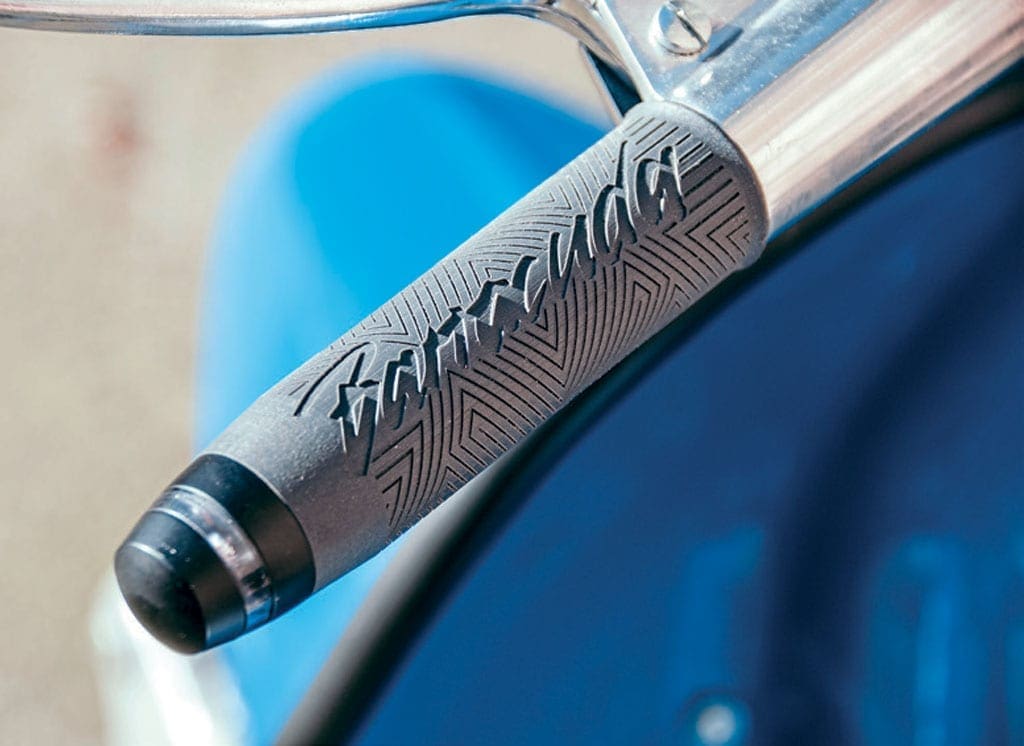
Words: Stan | Images: Julia Spitznas/Stan
What could possibly eclipse building a 50bhp Vespa? Perhaps a 250cc rotary valve, fuel injected Lambretta with a CNC milled engine case?
The mastermind behind Barracuda is no stranger to the pages of Scootering. Back in 2006 Felix Richter unveiled his Vespa project, ‘El Sidney’, a PX that would evolve into a liquid-cooled 50bhp monster.
What separated El Sidney from the competition wasn’t just outrageous BHP it was the neatness of its execution, particularly its unique CNC-milled engine case. “I love my CNC machines,” laughed Felix, “almost as much as I love my scooters.”
An engineer by training, Felix is fortunate enough to work in the world of high end CNC manufacturing and has access to some of the most advanced machinery that’s currently available. A long time scooter enthusiast it’s only natural that he’d turn his fertile imagination to improving them in his own style.

Complete concept
“I thought that El Sidney had reached a natural conclusion. I could have pushed it to 60bhp but where does that end? I’d learned a lot about engineering Vespas but wanted a fresh challenge.
“In Germany, just like the UK, there’s a divide between Vespa and Lambretta enthusiasts. They’re known as ‘chain scooters’ or occasionally ‘man’s scooters’.
“It took me about 10 years before I could bring myself to like the Lambretta enough to buy one and when I did it was a bare frame that I pushed to the back of my workshop.”
From the outset Felix was determined that this build would be more than ‘just a CNC Lambretta’. Instead he wanted it to be a single, cohesive concept. As Felix explained It was for that reason that planning started not with the mechanics but with the colour scheme.
“My first thought was to use the great ‘AF’ design but interpreted in a new way with carbon and CNC components. I soon realised that there are so many bikes with that design and it would be difficult to create something unique.
“I approached my good friend Andi Gutzeit, who has worked in design for many years and he became critical to the entire process. I searched the internet for inspiration and found Sebastian Vettel’s RB11 test car from 2011.
“This scheme was reinterpreted by Andi who used CNC, 3D-printing and paint to incorporate the design across the entire machine. The name ‘Barracuda’ was inspired by the streamlined, aggressive stance of a Lambretta.”

Pursuit of power
There’s no shortage of Lambretta tuning kits on the market but Felix isn’t a man who likes to take the easy route. Casting a very broad net he decided to use a Simonini top end intended for use on paragliders.
In the world of aviation not only is the power to weight ratio critical but there’s also a need for effective cooling. No one wants a seizure at 12,000ft!
With a factory claim of 33bhp at 8000rpm there was no doubt that the 230 Simonini was an interesting choice, the problem was that it’s fed by rotary crank induction. In simple terms it would be like bolting a PX kit onto a Lambretta crankcase. The two are simply incompatible.
The solution was to design a completely new crankcase, one with reed-valve crank induction. “I began by 3D scanning a standard Lambretta crankcase,” said Felix.
“From that computer model I slowly developed a crankcase that would accommodate both the reed-valve and Simonini top end. Several prototypes were 3D printed before I was happy with the results and committed to milling the final crankcase from a solid alloy billet.”
As Felix began to assemble the engine it was obvious that the standard Lambretta cooling cowls were no longer fit for purpose. Once again Felix turned to his beloved CAD design programme, producing ‘female’ molds from which carbon fibre cowls could be manufactured.
Casual observers could be forgiven for thinking that Barracuda has benefited from restrained engraving on the chain-case and rear hub but nothing’s as it seems on this build. The chain-case is one of Felix’s own design once again being produced by 3D scanning an original and incorporates a few detail functional changes.
The design is part of Andi’s overall aesthetic concept and was applied by the CNC machine while it cut the billet. This design is also incorporated into the rear hub which is a hybrid element with a steelinner contained in a hard coated aluminium shell.
Returning to Barracuda’s heart, the Simonini engine usually breathes through a 37mm Walbro carburettor. Fitting this would of course be far too straightforward for Felix who instead developed his own fuel injection system which operates at 4 bar.
For an exhaust Felix turned to BGM’s Big Box, the fitting of which proved to be one of the build’s easiest elements “A TS1 manifold fits the Simonini barrel without any modification,” laughed Felix.

Next
Barracuda is a stunning testimony to both Felix’s single minded determination and talents as an engineer. ‘Vorsprung Durch Technik’ means ‘Advancement through technology’ and while it may be associated with another German manufacturer the phrase sums up Felix’s attitude to scooters perfectly.
As for his next project, who knows where his fertile mind will travel next. For now he’s preparing to launch elements of Barracuda for sale via his online shop. Further information may be found at: www.cncvespaengine.wordpress.com



